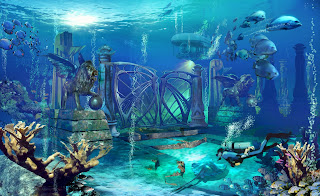Who owns the lake bottom?

Artist conception of Dennis Chamberland's underwater habitat "Lions at the Gate"
SIDEBAR OF STORY SIDEBAR WHICH APPEARED IN THE SATURDAY STAR BUT IS NOT ON THE PAPER'S WEBSITE. THIS IS AN UNEDITED VERSION OF THE PIECE
BOTTOMS UP ON LAKE ONTARIO OWNERSHIP
By Stephen Weir
The layer of scum and muck that covers the bottom of Toronto’s harbour is thick, but, not as deep as the red tape a builder would have to wade through to construct an underwater condominium. Who owns the lakebed? Who controls the water and who would issue building permits are three important questions that don’t have definitive answers.
“By and large the city ends at the waterfront,” said Gary Wright, the city of Toronto’s Director of Community Planning. “ There are a few cases, notably in Etobicoke where landowners have Riparian land rights (land owner is entitled to use the water on or bordering his property), but we wouldn’t be in a position to issue building permits.”
Even though the city does police the lakefront, operates ferries through into it, has built piers and laid water pipes on the bottom, the actual ownership does not lie with the city. “ There isn’t a clear cut answer,” said Diane Chester, a water expert with the city. “ It is confusing, but basically the city feels that the lake bottom belongs to the Crown and in some cases the Province has control.”
In Ontario the province says it has ownership of the lakes and rivers. However, the Federal Government, under the Canadian Shipping Act, lays claim to all International Waterways including the St Lawrence River and the Great Lakes. The Shipping Act is one of the oldest Acts in Canada and supersedes any provincial ownership’s claim. However, the McGuinty Government, in early 2006 passed a Heritage Act giving the province jurisdiction over 4 shipwrecks (and the lakebed they lie on) including Lake Superior’s Edmund Fitzgerald and Lake Erie’s Hamilton and Scourge.
“This is a very murky area of law right now, with different interpretations in different states and provinces,” said Dave Knight, program manager with the Michigan based Great Lakes Commission. “It is our opinion, however, that jurisdiction of submerged bottomland in Lake Ontario off Toronto most likely rests with the Province of Ontario.”
That may be, but, many Federal Agencies feel that they would have a say. “ The Fisheries Act, specifically section 35 (1) would come into play,” explained Colleen O’Mara, a Burlington based Communications Officer with Fisheries and Oceans Canada.
“ That section is called HADD – Harmful Alteration and Destruction of Fish Habitats, and a builder would have to prove that construction would not harm fish stocks and spawning beds.”
An environmental impact hearing would have to be held and either level of government could be involved. Environment Canada is unsure if it has jurisdiction over Lake Ontario’s lake bottom and when contacted by the Star a spokesman opined that the issue really belonged in the Foreign Affairs Department’s court!
If during construction of a continuum an American shipwreck was found, there could also be ownership claims from south of the border. In recent years both the United States Navy and private salvaging companies have laid claims to Great Lakes shipwrecks found on the Canadian side of the border.
Government officials at all levels agree that lakebed ownership is as clear as the mud that covers it.



Comments